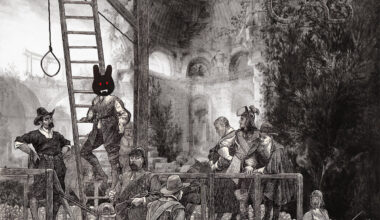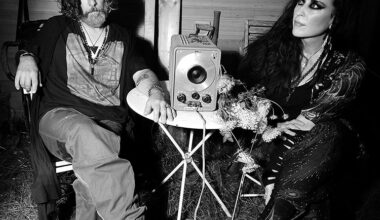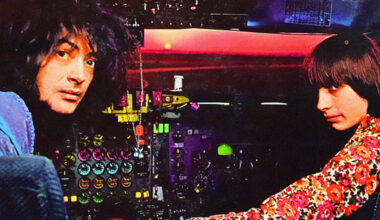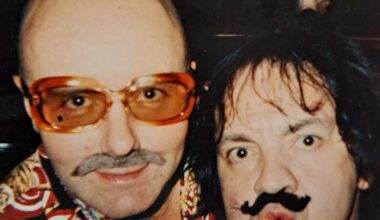Off the reviewing hook and free to scribble about whatever the heck he likes, this issue our esteemed columnist covers off The Doors, Beaver & Krause, crafty guitarist John Fahey and techno godhead Mike Dunn…
He remembers Beaver bringing his unwieldy new machine to the ‘Strange Days’ sessions
Nostalgia ruled with greater weight than ever throughout 2017 as it marked the anniversaries of both punk’s peak and the first Summer Of Love. Being of a certain age, I find myself being called on to remember both those landmark events, whether lecturing on the finer points of the Stones’ ‘Their Satanic Majesties Request’ or rambling about Hendrix or The Doors.
Obviously, ES-world saw several 1967 milestones in its still infant evolution, particularly amid the studio invention involved in creating psychedelic sounds along with Elektra’s mainstream introduction of the Moog synthesiser on ‘The Zodiac: Cosmic Sounds’ and Beaver & Krause’s ‘The Nonesuch Guide To Electronic Music’ demonstration album the previous year.
That was Paul Beaver on both, but recently I was talking to Bruce Botnick, the legendary engineer whose studio skill captured The Doors’ unique alchemy. He remembers Beaver bringing his unwieldy new machine to the ‘Strange Days’ sessions and using it on the other-worldly title track. “I put Jim’s vocal into the Moog then mixed it back against his vocal and added reverb,” explained Bruce. “Jim pushed the key and it produced that effect.”
Bruce created the nightmare musique concrète for Morrison’s ‘Horse Latitudes’ tone poem by manipulating the analogue tape machine through the studio’s echo chamber (“That’s how most stuff was done in those days”) and remembers George Harrison dropping in to see how the Moog worked. “I spent an hour showing him you can make cool noises with it,” he told me.
A remarkable album released 50 years ago that’s been largely overlooked

All this exploration got me thinking how new and exciting this electronic pioneering was to hear back then, let alone how its perpetrators must have felt as the first cosmic sounds came blasting out of their machines. This brings me to a remarkable album released 50 years ago last month that’s been largely overlooked against everything else going on at the time, but is a landmark early example of turntablism, sampling and collage away from avant garde enclaves. The album is ‘Requia And Other Compositions For Guitar Solo’ by enigmatic guitar iconoclast John Fahey, a personal favourite for over half a century.
Although best known for inventing the American Primitive style of steel-string guitar picking in the early 60s, Fahey was a fearlessly creative explorer of ethereal blues, surreal song titles, fake paper trails and, in his years before he died in 2001, senses-bleeding musique concrète when the mood took him. In January 1967, Fahey spent two days in a Hollywood studio with the aim of further realising what he described as the “cerebral symphonies” in his head that previously only manifested in his virtuoso guitar excursions.
The 21-minute ‘Requiem For Molly’ suite is intended to depict the mental unravelling of an old girlfriend “and the reaction of another person in observing this process, for which he was perhaps, to some extent, responsible”. As Fahey picks the Mamas & The Papas’ ‘California Dreaming’ and Charley Patton blues, the track becomes a demented kaleidoscope of proto-sampling, including Nazi marching songs, brass bands, old 78s, fairground organ, Hitler, jazz singers, tape loops, wedding music, white noise and his own found sounds, including seals.
Fahey was also in the mix when his buddies Canned Heat explored similar collage territory on the 20-minute ‘Parthenogenesis’ from 1968’s ‘Living The Blues’, both albums showing that, when it came to studio innovations, it was actually California’s freaks leading the way. Fahey would continue to go further out, when the mood took him. On 1968’s ‘The Yellow Princess’ he bases ‘The Singing Bridge Of Memphis, Tennessee’ on his recordings of cars going over a metal bridge. He wouldn’t stop there either and some two decades later was gouging the almost unlistenable noise of ‘The Mill Pond’ from his fevered psyche, some years before he sent himself out of this world on the aural Viking burial blaze of ‘Red Cross’.
The squelch buried in the circuits of a second-hand TB-303
DJ Pierre, Earl “Spanky” Smith and Herb Jackson must have felt those tingles of discovery when they stumbled on the squelch buried in the circuits of a second-hand TB-303 bass machine and produced Phuture’s ‘Acid Tracks’ in 1987. The track inspired and named an entire movement that included many more Chicago house missiles over the following few years. Initially a protégé of the legendary Ron Hardy (Chicago’s Larry Levan, sure, but also one of the last century’s most important electronic renegades), Mike Dunn was in the thick of it, releasing classics like ‘God Made Me Phunky’ and ‘So Let It Be House!’, a member of Felix Da Housecat’s Radikal Fear Chicago All Stars crew, causing all kinds of house havoc in his own right and with all the other original players. Unlike so many of his contemporaries, Mike is still at it now after some years of problems, which is why it’s so gratifying to find him releasing his first new album since 1990.
‘My House From All Angles’ could be this decade’s most compelling old school Chicago statement, deploying a blistering yet subtly crafted array of resonantly deep grooves, raw jack attacks, analogue soul and crowd-detonating hooks on self-explanatory titles such as ‘Acid Rush’, ‘Body Muzik’, ‘Move It, Work It’ and ‘DJ Beat That Shhh’. As the album’s title suggests, Mike has an arsenal of styles at his disposal, as heard on a darkly hypnotic ‘The Frontier (9-1-1)’, astonishing ‘The Wake-Up Call’ and ‘You R’, which uses chomping 303, dramatic strings and a returning JR Jordan (the same bloke who sang Pierre’s Phantasy Club’s ‘Fantasy Girl’ 30 years ago!).
Somehow we’ve got from The Doors 50 years ago to a Chicago house legend finally releasing his masterpiece but, next to the twin towering sets by Alan Vega and Martin Rev, this could well be my album of the year. All that remains is to wish you all a fantastic Christmas and 2018 (many more anniversaries there!) and to tell you about our spectacular new rabbit Loftus, except I’ve run out of room…





